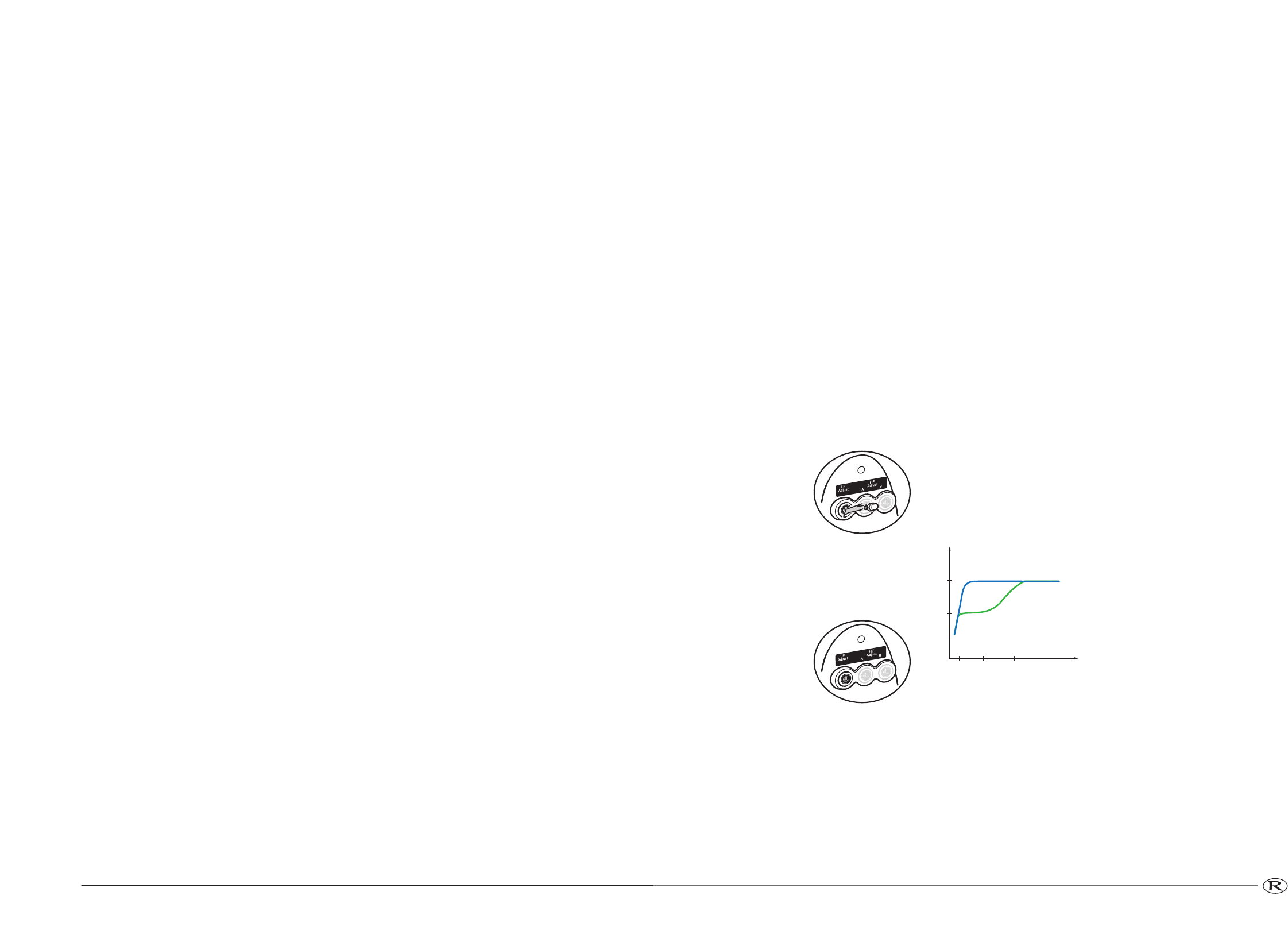
14 15
All connections should be made with the
amplifier switched OFF. Ensure the integrity of all
connections prior to switching the amplifier ON.
KEF Reference Series loudspeakers are
fitted with purpose designed gold-plated
Tri-wire/Tri-amp terminals which will accept
bare wire, spade or 4mm connectors.
Most good quality loudspeaker cables have some
indication, such as colour coding or ‘ribbing’
on the insulating material, indicating which
conductor is ‘+’ or positive. Connection to the
loudspeakers can then be made as follows:
The left channel amplifier output terminal
marked ‘+’ or coloured RED connects to the left
loudspeaker terminal marked ‘+’. The left
channel amplifier output terminal marked ‘-’ or
coloured BLACK connects to the left
loudspeaker terminal marked ‘-’. Similarly,
these instructions should be followed for
making connections between the right channel
amplifier output and the right loudspeaker.
Correct polarity, or phase, is vital to the proper
operation of the system.
If the connections are not made correctly the
sound will deteriorate giving poor bass output
and a diffuse presentation of the soundstage.
Bare wire connections are the simplest to
achieve and involve stripping 12.5mm (1.2in.) of
insulation to expose the loudspeaker wire core.
(You should twist together, using clean fingers,
the ends of each multi-stranded core prior to
the next stage to ensure a good signal contact).
Having unscrewed the lower terminal cap,
push the wire through the exposed hole in the
terminal body and screw the cap down tightly.
Make sure that no stray strands come into
contact with the opposite terminal; this could
cause a short circuit between the terminals and
may damage your amplifier.
Be aware that a higher quality run of cable will
always give a more rewarding presentation than
multiple runs of an inferior cable.
Amplifier to Loudspeaker Connections
Models 201/2, 203/2, 205/2, 207/2 and 206/2ds
incorporate separate adjustments for bass and
treble output situated at the top of the terminal
panel (see below). The left hand terminal
allows a two position bass level adjustment
while the centre and right hand terminals
allow a four position tweeter level setting.
Three gold plated screw caps are supplied with
each loudspeaker, one for the LF and two for the
HF adjustment.
LF Adjustment
With the supplied cap screwed into the
‘LF Adjust’ terminal the bass level is set at the
‘flat’ setting - for free space positioning. When a
loudspeaker is positioned close to a wall
the perceived bass level is increased by
approximately 2dB.
If the cap is removed from the LF Adjust
terminal the bass level is reduced to correct
the loudspeaker response for the proximity of
the wall.
Uni Balance Adjustment
2. Cut
cap out
1. Flat
cap in
1
2
Level (dB)
Frequency
300 Hz150 Hz50 Hz
-2.0
0.0
Mode
LF
level (dB)
1. cap in 0.0
2. cap out -2.0
In KEF literature and in the specification
table within these instructions are listed
a range of amplifier power outputs to match
your Reference Series loudspeakers.
Conditions of use (room size, type of
programme, preferred listening level) and the
nature of the loudspeaker/amplifier interface
vary so widely that it is not possible to lay down
hard and fast rules about amplifiers and the
loudspeakers they drive.
KEF loudspeakers are built to rigorous standards
of quality and consistency and the upper limits of
the amplifier requirements shown are those
which the loudspeaker in question should handle
without distress or damage when used under
normal domestic conditions.
If higher than specified amplifier powers are
used, great care should be taken to avoid
abnormal conditions such as switch-on surges or
gross distortion, either of the amplifier or the
loudspeaker, resulting in power peaks greatly in
excess of the ratings specified. Care should be
taken as the possibility still exists under certain
conditions (such as excessive bass or treble
boost caused by tone and/or loudness controls,
graphic equalisers, etc.) that the loudspeakers
can be overloaded and damaged. The lower
limits of amplifier power are those necessary to
give a reasonable sound pressure level under
domestic conditions.
Remember it is easier to damage the
loudspeaker by using a small amplifier driven into
distortion by too much volume, possibly with
bass and treble boost, than by using a larger
amplifier which has power in reserve.
If in doubt, ask the advice of your retailer
or consultant.
Amplifier Requirements and Power Handling
Models 201/2, 203/2, 205/2, 207/2 and 206/2ds


















